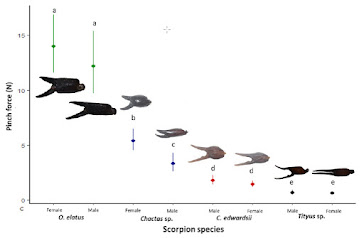The family Pseudochactidae Gromov, 1998 consisted for many year of only one genus and one species. In recent years a few more genera and species have been described, many from isolated areas. Victoria Tang has now described a new genus and species from the Yunnan Province of China, greatly increasing the distribution of this family.
Qianxie Tang, 2022
Qianxie solegladi Tang, 2022
The new species seems to be found only above ground and it exhibits no troglomorphism, which is different from its presumed sister genus, Troglokhammouanus Lourenço, 2007.
Abstract:
A new monotypic genus belonging to the basal scorpion family Pseudochactidae Gromov, 1998, Qianxie solegladi gen et. sp. n., is described from Yunnan Province of China. The family is recorded from China for the first time, vastly extending its known geographic range. The new genus shares morphological characters with both Pseudochactas Gromov, 1998 and Troglokhammouanus Lourenço, 2007. It differs from Pseudochactas and is similar to Troglokhammouanus in the shapes of anterior and posterolateral carapace margins, form of the circumocular sutures, distance between median ocelli, development of dorsoventral projection of patella, length of tarsal spinules, recurvature of the lateral margins and concavity of the surface of the sternum. It is similar to Pseudochactas in the degree of carapace granulation, pedipalp manus carination, secondary accessory and retroventral carinae of the chela manus, numbers of lamellae and teeth on the pectines, development of the median lateral carinae of metasomal segments III–IV and ventromedian carina of metasomal segment V. The new genus is hypothesized to be more closely related to Troglokhammouanus than to Pseudochactas and is placed in the subfamily Troglokhammouaninae.
References:
Tang V. A new scorpion genus and species from China, Qianxie solegladi gen. et sp. n. (Scorpiones: Pseudochactidae). Euscorpius. 2022(351):1-19. [Open Access]
.jpg)









